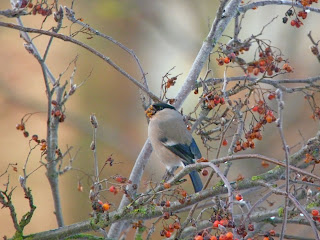It`s been a while coming, but finally I have seen a fairly large flock of Waxwings and not only that, but they were on my local patch of Peterborough. These birds were seen in a car park of a local business park on Friday the 26th and were still showing today, sometimes down to 20 yards! There were up to 55 birds in total, ranging from 1st winters to full adults.
The Waxwing is a species which has `eruption` years, that is to say that most years we can get 100 or so birds in the whole of the country, but on `eruption` years, several thousand can be present, this is one such year! They breed in northern Scandinavia and Siberia and come to
Britain when their food source is depleted. The favourite food is berries (indeed a Waxwing can eat 2 or 3 times its own bodyweight in a day), rowan, whitebeam and hawthorn, but they also eat cotoneaster, rose-hips and other winter fruits and seeds. On their breeding grounds they eat insects, especially mosquitoes and midges.
The Waxwing is slightly smaller than a Starling with a prominent crest, black bib, small black mask, a yellow tipped tail and a pattern on the wings of yellow and white, with the secondary flight feathers having a series of `spikes` which look like bright red wax, hence the name Waxwing.
A truly stunning bird!


















